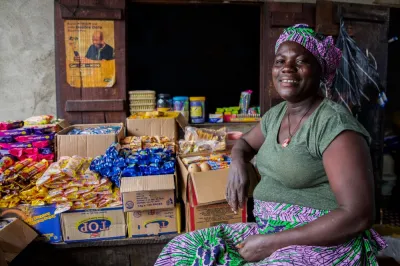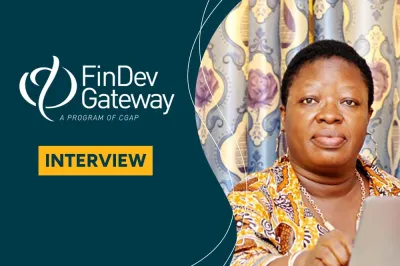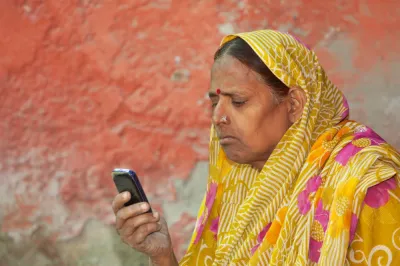Last in Line for Financial Inclusion: How Smallholder Farmers Can Move Forward with Digital Finance

Anita Campion is a rural and agricultural finance expert with more than 20 years of experience in international and US finance and private sector development. She is President and CEO of Connexus, an international development consulting firm which organizes the annual Cracking the Nut conference on agricultural finance and development. This year’s conference takes place from March 27-28 in Bangkok, Thailand and is focused on cracking the tough nuts associated with reinforcing food systems to meet urban demand.
Gateway: Despite its many advantages, the use of digital financial tools in agriculture, especially among smallholder farmers, remains very limited in some markets, as a recent CGAP study found. What are some of the key factors that are limiting the use of DFS by smallholders? How much of the limited use is driven by demand side factors (e.g. limited connectivity, lack of understanding of DFS) versus supply-side factors (e.g. DFS solutions are not tailored to the specific needs of smallholders)?
Anita: To answer this question, it is important first to distinguish between the limiting factors of smallholders’ access to finance in general from the factors that limit their use of digital financial services. In my mind, the biggest hindrance to smallholders’ access to finance comes from banks and other financial institutions’ lack of appropriate products and services to meet smallholders’ financial needs. This is partly due to higher risks, such as those associated with production, higher costs to serve rural areas, as well as opportunity costs (most financial institutions focus on larger clients that can offer fully collateralized loans).
DFS is a tool that can help to overcome some of these factors, such as by reducing transaction costs, but that only works once financial institutions have made a commitment to serve the smallholder market with a methodology that encourages on-time repayment. According to the CGAP study, many smallholders have access to the technology required for DFS, even if connectivity is often less reliable in rural than urban areas. The greatest barrier to smallholder finance comes from the supply side. However some of the digital finance tools that will be highlighted at the Cracking the Nut 2017 conference on March 28 in Bangkok help to mitigate risk.
The greatest barrier to smallholder finance comes from the supply side.
Gateway: Can you share with us some examples as to how digital finance tools can help smallholders to manage risk?
Anita: All three of the panelists for the session that I will facilitate, "Using Digital Financial Services to Expand Outreach," use DFS in a way that simultaneously reduces risk as well as transaction costs associated with smallholder lending. In this way, these technologies offer incentives to financial institutions to reconsider the smallholder market.
Lenddo uses non-traditional digital data to create a credit score, including information on social media and cell phone payment histories, which have proven to be good indicators of character and risk.
ESOKO provides a virtual marketplace through which they offer group discounts on agricultural inputs. Farmers pay for these services using digital wallets. This offering takes advantage of volume discounts to attract large numbers of smallholders that FIs can then serve with a variety of digital financial services, including savings and credit products.
Other companies serve smallholders with information on weather, crops and market pricing via SMS messaging, which helps to reduce production risks for farmers, making them more attractive to lenders. Farm Drive in Kenya has developed a mobile application that facilitates the flow of such information between farmers and FIs so as to mitigate credit risks and facilitate lending.
Gateway: While DFS offers great benefits for both providers and customers, it also has the danger of exposing smallholder farmers to new risks that they may not fully understand. In your view, is enough being done to understand what these risks are and address them adequately by all relevant stakeholders?
Anita: From my experience, smallholder farmers are very familiar with managing risks and tend to be conservative when taking credit risks. Nonetheless, as with any new product or technology, the offeror has an obligation to the client to make sure they fully understand how it works and what to do in case of problems.
In addition to understanding credit risks, DFS users need to understand that their access to the service might be limited by their access to the Internet or ability to charge their cell phone. In implementing a new DFS, financial service providers (FSPs) should develop a list of frequently asked questions and common problems, along with suggestions, solutions and contact options in case something goes wrong or the client is not able to meet the terms of the agreement.

Gateway: How important do you think personal interaction will continue to be in building and maintaining relationships between FSPs and smallholders as DFS comes to play an increasingly important role in agriculture finance in the future?
Anita: The difficulty with agribusinesses is that they generally have unique risk profiles, depending on the mix and variety of crops, and their access to risk mitigating technologies (such as drought-resistant seeds, fertilizers, irrigation, and crop insurance) all of which must be taken into account. This reality, combined with the volatility and lumpiness of production and revenues, as well as co-variant risks associated with seasonal demand and supply of investment funds, will continue to make smallholder finance complicated, relatively expensive and scarce.
There are some FSPs that are willing to invest in building and maintaining relationships with individual smallholders, such as Diamond Bank in Nigeria. In these cases, DFS can help to lower costs of transactions related to expanding savings or providing follow-on loans after conducting an initial analysis. Other FSPs seek ways to target and serve multiple smallholders that work in similar value chains simultaneously, often through key value chain actors (e.g. aggregators, processors or wholesalers). If there is a clear end buyer of the smallholders’ production, this substantially reduces the market risk, which is often a greater concern than production risk for agricultural lenders.
By building on these relationships of trust and mutual interest, FSPs can negotiate agreements that pass some of the smallholder risk profiling and mitigation to the key value chain actor. The bottom line is that some level of relationship will often be required to forge financial linkages between smallholders and FSPs, but once established, DFS offers endless opportunities for expanding services and cross-selling other products. As more data on financial clients becomes available, it becomes easier to monitor risks and identify new products and services to accommodate changing agribusiness needs.
Gateway: Looking ahead, what are some of the key factors that will drive the financial inclusion of smallholder farmers in the next ten years?
Anita: Given the complexity of lending to smallholders, I think they will remain the last to be served among the financially excluded. DFS will definitely be a driver of financial inclusion, but examples from Kenya and Tanzania have shown that urban consumers with stable, salaried employment tend to be the initial beneficiaries of DFS, such as mobile money transfers, online savings accounts and automated credit lines. Only once a certain volume is reached does DFS become cost-effective and accessible to the rural poor.
Nonetheless, in the next ten years, I am confident that the telecommunications and financial infrastructure will become more developed and linked between developed and developing nations, as well as between urban and rural areas, so as to significantly increase financial inclusion overall, including smallholders. Forward-thinking FSPs will focus heavily on mobilizing savings through DFS even from rural areas and will use data analysis to help them identify and pinpoint market opportunities that remain unserved.



This is a well-detailed content! Thank you for sharing and I'm looking forward to more blog content.
Leave a comment